Charlie Falconer’s testimony
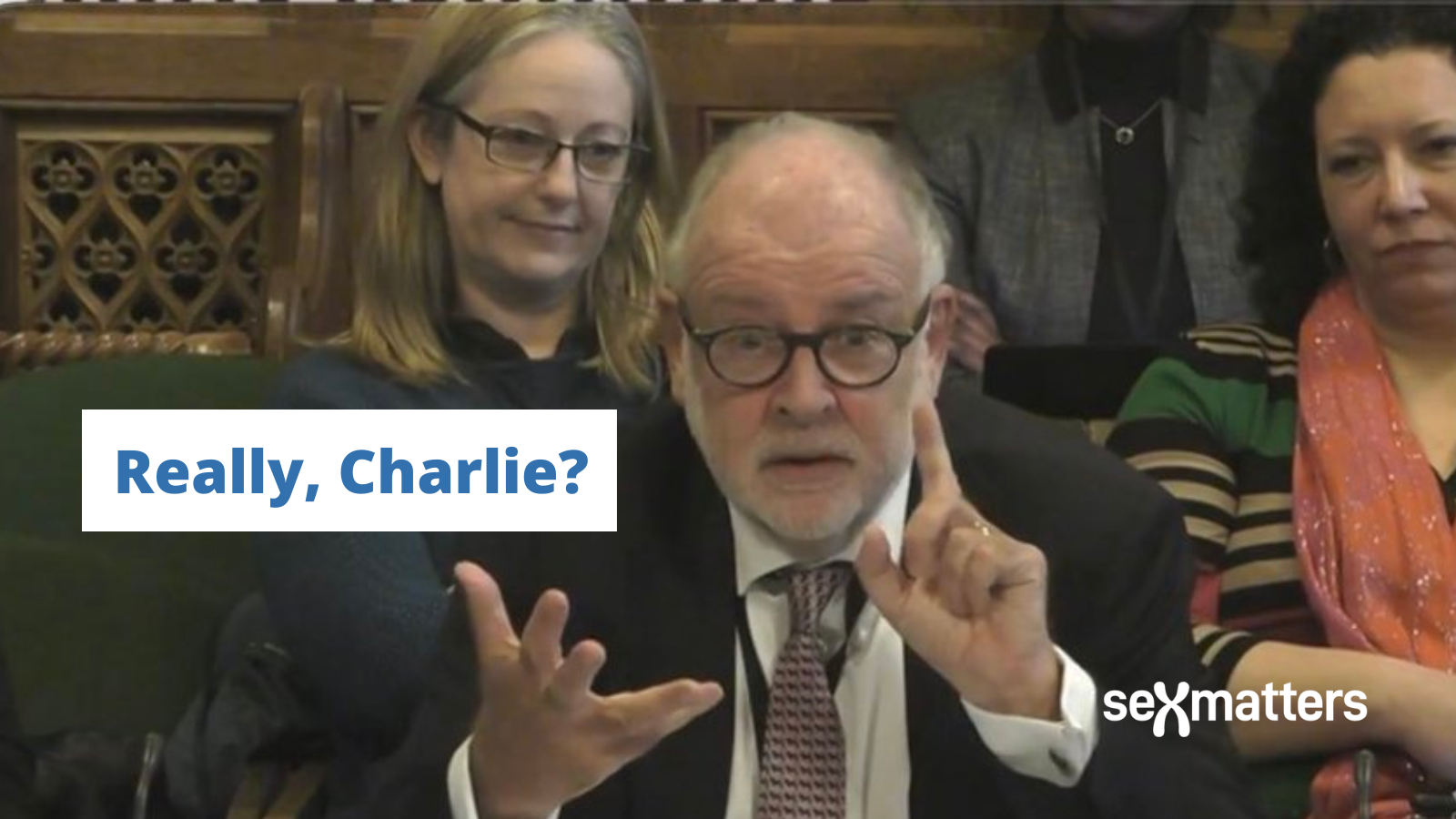
The Women and Equalities Committee held an evidence session on 31st January on the Gender Recognition Reform Bill and the Equality Act.
It featured Robin White, Barrister at Old Square Chambers; Naomi Cunningham, Barrister at Outer Temple Chambers (and Sex Matters’ Chair); Dr Michael Foran Senior Fellow, Policy Exchange and Lecturer in Public Law at Glasgow University; and Lord Falconer of Thoroton KC.
It is unusual for a working peer to be called as an expert witness, and it was not clear whether Lord Falconer was there as a KC, a previous minister or a current Labour peer. He was apparently invited because he wrote a Twitter thread.
Murray Blackburn Mackenzie has already written a blog post on that thread criticising Lord Falconer’s emphasis on the figure of 525 new applicants per year as being minimal, while he ignores how this will add up over the years.
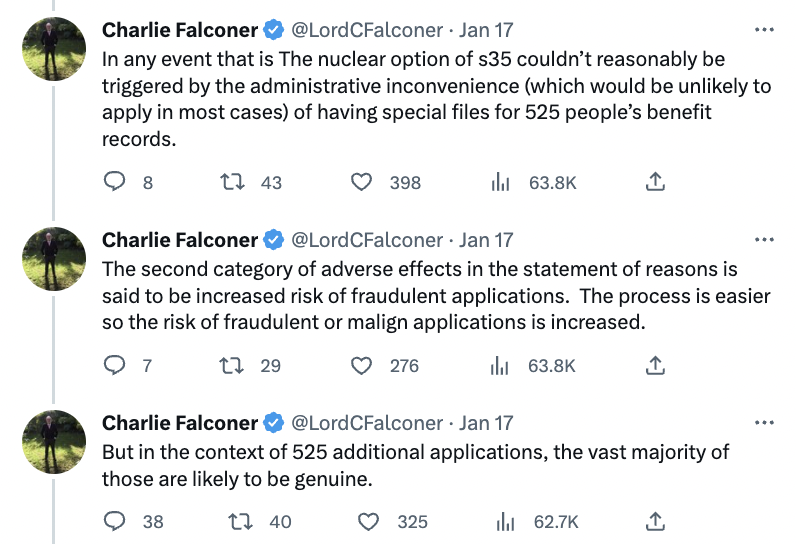
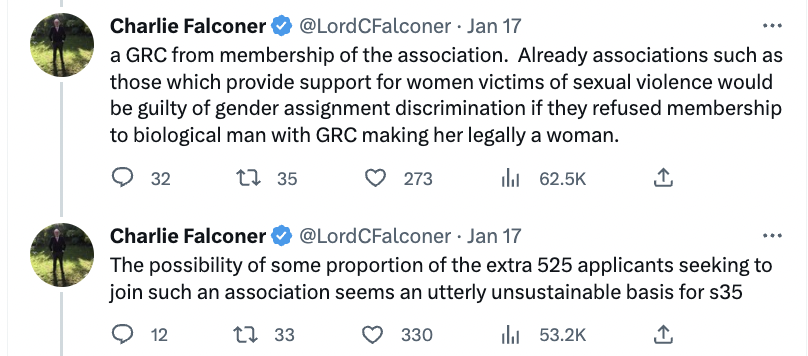
Numbers
When Dr Michael Foran mentioned Murray Blackburn Mackenzie’s criticism, Falconer responded that 525 was the estimate from the UK government, but did not acknowledge the basic arithmetical point that annual additions add up to a larger sum.
Anum Qaisar MP was left not understanding that an estimate of 500 people is consistent with “thousands upon thousands”. The UK government’s numbers in fact predict 2,625 after five years, 5,250 after 10 years and so on.
The Equality Act and “safe spaces”
Lord Falconer kept talking about “safe spaces” in relation to the Equality Act, and argued that individuals in charge of decision-making have to make a decision about whether to exclude a particular man who identifies as a woman on a case-by-case basis.
This is a fundamental misunderstanding of the Equality Act, which does not mention “safe spaces” at all. Nor does the Statement of reasons related to the use of section 35.
What the Equality Act says is that service providers are allowed to provide “separate services for the sexes” and “single-sex services” for a wide variety of reasons, including that a person of one sex “might reasonably object to the presence of a person of the opposite sex”:
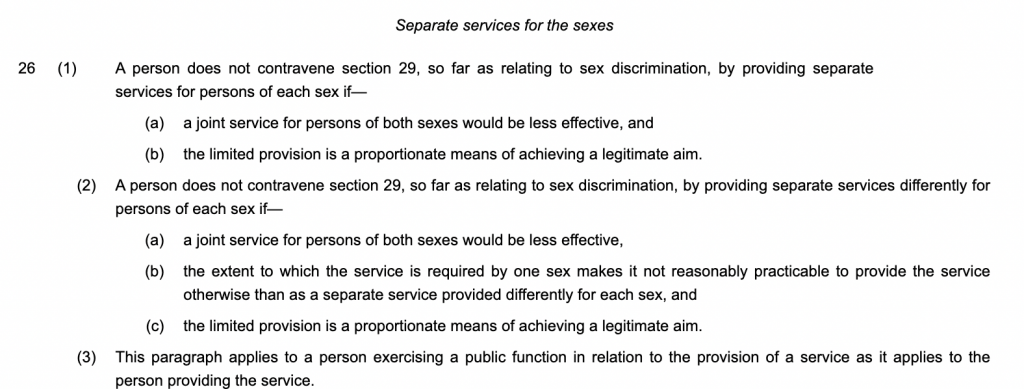
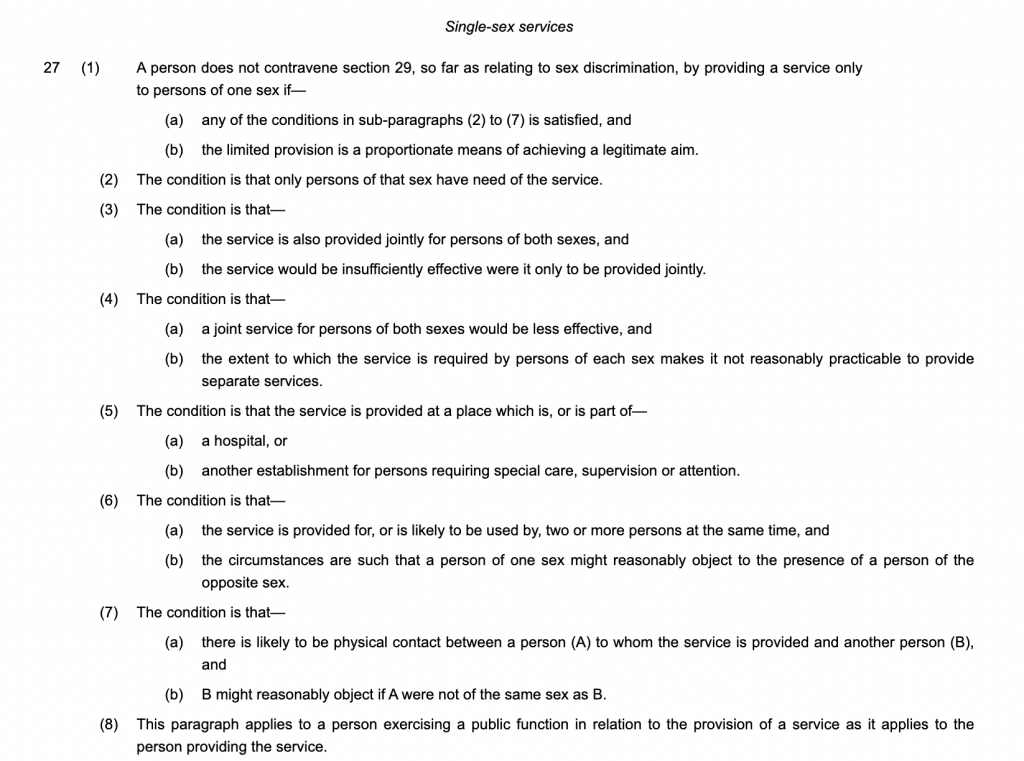
These reasons are not principally about safety but are often about everyday dignity and privacy – and providing services that meet the needs of people of either sex, where these are different.
Falconer returned again and again in his testimony to the example of running a prison. He said that having a GRC makes “absolutely no difference” to decisions about prison allocation. This is precisely wrong.
The prisons policy in Scotland is under review, but in England and Wales it states that “a person remanded into custody must always be initially allocated to an establishment which matches their legally recognised gender”. After this a risk assessment takes place, but if they have a GRC they can only be transferred on an exceptional basis:
“4.12
At either board, individuals who are transgender must be asked for their view of allocation within the prison, Youth Secure Estate or Approved Premises estates (i.e. male or female). Where an individual expresses a view of location that is consistent with their legally recognised gender, the Local Transgender Case Board should generally consider how the case should be managed appropriately within that location. However, there may be exceptions where the risk to the individual is deemed too high to manage in that location, or where the view expressed is thought to have been influenced inappropriately, in which case a Complex Case Board may still need to express a balanced view on location.”
Possession of a GRC is also considered a “critical factor” in the risk assessment itself.
Furthermore, in the day-to-day operation of the prison the biological sex (or so called “gender which was assigned at birth”) of a prisoner with a GRC must not be disclosed without their consent (even where it is perfectly obvious what their sex is) apart from in the specific circumstances set out in S.22 of the Gender Recognition Act:
“Seek written consent to disclose the sex assigned at birth for individuals who are protected under the Gender Recognition Act 2004
4.54
All individuals who disclose that they have applied for, or have gained, a GRC must be asked to provide written consent for their gender which was assigned at birth, and/or details of the application process, to be disclosed to/from relevant staff in or on behalf of HMPPS. Consent is entirely voluntary on the part of the individual. The benefits of disclosure may be explained by staff, which include gaining a more informed approach in planning their care and management, and may also assist in gaining an increased understanding of the triggers for offending and to improve sentencing outcomes.4.55
Systems must be in place to maintain records which are compliant with the Gender Recognition Act 2004 and do not identify a different gender or GRC application process where consent has not been given and where exemptions in s22 GRA 2004 do not apply. If consent is withheld, the previous gender and/or details of the application process must not be disclosed unless exemptions under s22 of the GRA 2004 apply (see Legal Requirements section and supporting operational guidance).”
“Protecting women and girls”
Lord Falconer said that the issue of protecting women and girls is “essentially the safe spaces issues”.
He seemed oblivious to other more day-to-day single-sex spaces such as toilets, changing rooms, showers, dormitories, swimming pools, gyms and other women-only classes, and services involving bodily contact such as massage and waxing, which are also covered by the Equality Act.
Whether women are able to use the showers in the gym without a naked man sharing them, or trust that they will not wake up with a man in the next bed in a women’s dormitory or women’s hospital bay, or open a small beauty business serving women only, or organise women’s reading groups or drama groups, lesbian hiking clubs, women-only sports associations, religious groups or feminist student societies without being forced to accept men who identify as women, was of no concern whatsoever to him.
He did not engage with the arguments made by Naomi Cunningham and Michael Foran that the Equality Act concerns the rules that organisations are allowed to set and the ease with which they can communicate and apply them to categories of people.
The Statement of reasons, which Falconer disagrees with, sets out four key areas where the UK government believes that the GRR Bill adversely affect the operation of the Equality Act:
- clubs and associations (where exceptions apply in respect of sex but not in respect of gender reassignment)
- the operation of the public sector equality duty
- equal pay
- provisions where exceptions apply for both sex and gender reassignment.
These provisions in the act apply equally to men and women, but they tend to particularly protect women, who are more often disadvantaged in practice. The S.35 Order identifies them as “existing problems” of the GRA which would be made worse. It is worth noting that in 2003 Falconer was the Secretary of State for Constitutional Affairs, the ministry responsible for developing the Gender Recognition Act. This might explain his reluctance to consider existing problems with the GRA.
Risk assessment
Lord Falconer placed great faith on risk assessment.
In most situations outside prison there is no possible means of individual risk assessment. It would be a breach of Article 8 privacy to ask someone for the information you might use to risk-assess them, and there is no process for it. Even in prison it is impossible to risk-assess which male criminals who want access to female prisoners might be rapists; only which ones are known to be rapists.
Women live their lives in a constant state of risk assessment. If the rules and categories are changed so that a service provider cannot provide intimate spaces where women do not risk being surprised, frightened, humiliated or harmed by the presence of males, many women will make their own personal risk assessment and self-exclude from that aspect of public life altogether.
Everyone should agree on the law
Here Lord Falconer made the good point that the UK government and the devolved governments should have a clear idea of how the Gender Recognition Act and the Equality Act work together. But again he focused on the idea that the only concern is “safe spaces” and not the issues that the Section 35 Statement of reasons actually raises, which are about the Equality Act providing coherent protection against sex discrimination, including allowing clear, and workable rules on single-sex services, associations, colleges, schools and sports.
Let’s not talk about cross-dressers
Falconer dismissed the idea that by removing the requirement for medical assessment the Bill would allow erotic cross-dressers and others to obtain GRCs.
Doctors who undertake medical assessment seek to rule out other reasons for a person believing they will be happier trying to live as if they were the opposite sex: autism, autogynephilia, psychosis, depression and dementia are just some of the differential diagnoses noted by Dr James Barrett, Director of the adult Gender Identity Clinic at the Tavistock Clinic. Cross-dressing (transvestism) is well understood as a common paraphilia of men. Dr Barrett says:
“Men are said to display dual-role transvestism when they spend a significant portion of their life in a female role, valuing the expression of female feelings this allows. It is not sexually driven but might have evolved from a previous fetishistic transvestism.”
He notes that such men are predominantly heterosexual and view their male genitals as valuable.
Lord Falconer’s confidence that these men (including those for whom their transvestism remains an erotic focus) might not become seized by the idea of becoming legal women once the requirement for differential diagnosis is removed is without evidence. Indeed the expansion of the “transgender umbrella” has already reclassified this group of people as “transgender”.
In 2003/04 it was Lord Falconer’s own department that was careful to make the distinction between transvestites and transsexuals, designing the system of medical gatekeeping that Falconer is now seeking to remove.
International gender recognition: nothing to worry about
Asked about opening up the international track to people who had obtained legal recognition in any country, Falconer couldn’t see how this this could be a problem. “There may be some problems about: are there countries that have no standards at all?” he said. “But I don’t know of any, so in practice I don’t think that is going to be much of a problem.”
Perhaps he hasn’t heard of Ireland.
Getting the law wrong
What was clear throughout Charlie Falconer’s testimony was that he was describing a system of law that simply does not exist.
Under the Equality Act, he said, there are certain things that need special protection – “and in relation to that special protection there are rules that say don’t worry if someone has a GRC or not, look and see what the risk is.”
This is not what the Equality Act says. It provides statutory exceptions that enable single-sex services to be provided, alongside many other exceptions that allow discrimination in relation to other characteristics such as age, race, religion and marriage.
There is nothing in the Equality Act which requires single-sex service providers to “look and see what the risk is” for individual men who say they are women, and allow them to use women’s services. This would be impossible.
Following his imaginative take on risk assessment, Lord Falconer said something quite extraordinary: that a small service-provider can not only risk-assess individual males, but also distinguish between a person who has changed their Scottish birth certificate to “female” using a UK GRC and someone who has done so using a Scottish GRC – although there would be no difference on the face of the birth certificate.
Finally Lord Falconer suggested that self-ID already is the law. He said that the law regards a “trans woman as a woman” even if they don’t have a GRC.
He didn’t point to any law that says this. That is because there isn’t one.
It is recognised in common law that sex is biological, binary and immutable, reflecting chromosomes, genitals and gonads, and cannot be changed by medical or surgical means. This was held in Corbett v Corbett [1971], R v Tan [1983] and Bellinger v Bellinger [2003] and confirmed again in Forstater v CGD [2021].
Sex in any particular law can mean biological sex or sex as modified by a Gender Recognition Certificate (see the statement by Lord True in May 2022).
There is no legal status of “trans woman”. Someone who calls himself a “trans woman” and does not have a GRC remains in law a man (with the protected characteristic of gender reassignment under the Equality Act).
Most people support self-ID?
Going beyond misrepresenting the law, Lord Falconer stated that “most people” accept that the Scottish GRR Bill is a sensible change. He offered no evidence, and he is simply wrong about this. In December 2022, YouGov carried out a survey of 1,090 Scots on behalf of The Times and found that:
- three out of five people, or 60%, said they disagreed with the proposal to do away with a dysphoria diagnosis; only 20% said they supported it
- when it came to lowering the age limit, 66% were opposed and only 21% in favour
- 59% of those polled said they were opposed to the plan to shorten the time a person would need to live in their acquired gender, with only 21% in support.
